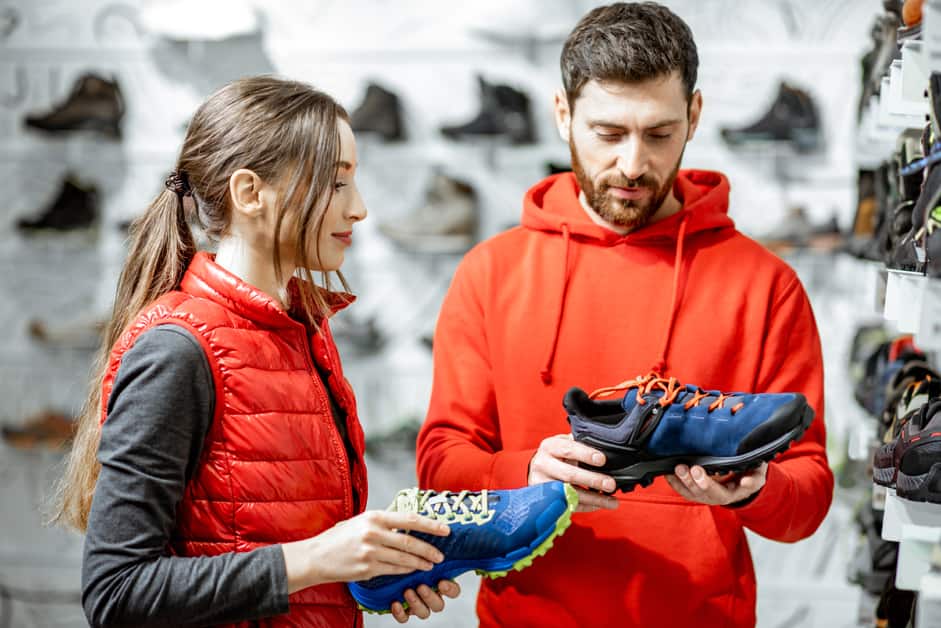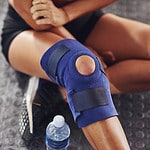Introduction
Knee pain? Your feet may be to blame. Wrong shoes can cause extra stress on the knees and lead to pain and joint damage. The good news is that the right shoes can help reduce knee pain.
Get shoes that fit your needs and give your gait biomechanics and overall musculoskeletal health a boost. Choose shoes with:
- Supportive soles,
- Arch support,
- Cushioning,
- Shock absorbers,
- Stability,
- Comfort, and
- Breathability.
The sole should absorb shock as you move. This will help prevent over-stretching near affected joints, making your knee problems less painful.
Types of Shoes for Knee Pain
Choosing the correct shoes to ease knee discomfort can be tricky! With so many options, it’s essential to find a pair that gives good arch and heel support, is comfortable and won’t worsen the pain.
In this article, we’ll go over the different kinds of shoes that can help with knee pain:
Motion Control Shoes
Motion control shoes are designed for people with mild to moderate overpronation. These shoes provide stability and cushioning. They give your foot a solid base, while controlling flexibility. The added cushioning helps reduce pressure when you move, and stress on your knees.
Motion control shoes have a broad base for stability and enough flexibility for free movement. They also have a firm heel counter which keeps your heel aligned with the rest of your foot. Common types of motion control shoes include walkers and running shoes. These can be made from hard, dense materials like leather or synthetic material. This gives them superior durability and protection against wear and tear.
Stability Shoes
Stability shoes are designed to provide superior motion control. This helps reduce the impact on knee joints, keeping them aligned. For extra cushioning, the heel and forefoot areas have additional padding, plus a rigid sole in the arch. Also, the heel contains a soft yet firm plastic counter. This makes the shoe comfy, while also supporting the foot in its correct position during activities like running or tennis. Stability shoes are ideal for those with knee pain, as they protect the joints from overstrain.
Some details:
- Heel-to-toe drop: Low drops (10mm or less) promote good posture and extra support for bad knees.
- Pronation: Wear patterns show if you pronate or supinate.
- Toe box width: Too much room inside the toe box causes irritation and reduces stability for runners. Stability shoes usually have narrower boxes.
- Roomy fit: Shoes shouldn’t be too tight, allowing enough space for ankle flexion during activities.
Cushioned Shoes
Having the right shoes is essential for easing knee pain. Whether from arthritis or injury, the right shoe can make a difference. Cushioned shoes provide cushioning and reduce pressure when walking and running. When shopping for them, fit and support are key.
- Shoes should fit snugly and comfortably, with foam inserts and contours to cradle feet.
- Additionally, look for arch support to reduce pressure on joints and muscles.
- Good support is also important; features like stability, reinforced heels, and extra straps help keep feet in place.
- Lastly, lightweight materials such as mesh bodies allow feet to breathe, while keeping them light.
How to Choose the Right Shoes
Choosing shoes? It can be tricky. To dodge knee pain, you need to pick the right ones. Here are helpful tips on finding the correct shoes for ease of knee pain. Consider these factors: it’ll help you make the decision!
- Size: It’s important to get shoes that fit properly. Shoes that are too small can cause pain and discomfort, while shoes that are too big can cause blisters.
- Arch Support: Shoes should have adequate arch support for your feet. If the arch support is too low, it can cause the foot to roll inward, leading to knee pain.
- Cushioning: Shoes should also have adequate cushioning to absorb shock and provide support to the foot. Shoes with too little cushioning can cause knee pain.
- Material: Shoes should be made from breathable materials to keep your feet cool and dry. Non-breathable materials can lead to excessive sweating and blisters.
Consider your needs
When considering shoes, think about what you need. For instance, do you require cushioning for your knee? Do you need special support for your foot or ankle? Or is extra arch support what you need? What about extra stability or motion control?
Also think about which surfaces and activities you’ll use them for. Are you taking a short walk or running long distances? Will you mainly walk on flat surfaces like roads, or also on rough terrain such as hills and gravel paths?
These questions can help you choose the right shoe for reducing knee arthritis pain. Your medical provider may also give advice about features that fit your needs.
Consider your activity level
When choosing the best shoes, consider your activity level. If you’re an athlete, look for motion control and cushioning. For walking, there are comfy and flexible options. Your foot type can influence fit and support. Check that each foot is the same size. Remember wide or narrow sizes too!
For hot climates, go for breathable fabrics like mesh or canvas. For cold climates, thicker materials like leather are great. Think about how often you’ll wear them. Invest in good quality shoes that will last longer.
Consider the type of terrain you’ll be walking on
Walking shoes come in many shapes and sizes. It’s essential to pick the correct pair to lessen knee pain. Consider the terrain you’ll be walking on when deciding.
- For rough surfaces, rubber soles are best for shock absorption. And, make sure the shoe has good arch support. This stops the knees from over-stressing.
- For smooth surfaces like sidewalks and roads, leather or synthetic fabric can provide cushioning. Look for thin, flexible soles. They give stability whilst allowing the foot to move naturally with some cushioning and arch support.
Conclusion
To sum up, getting the best shoes for knee pain can be tough and take a while. It’s important to look at things such as cushioning, help, steadiness and fit when choosing. Certain shoe types offer advantages for people with knee pain. For example, running shoes have shock absorption which helps those with PFPS.
It’s crucial to choose shoes that give cushioning, help and steadiness for maximum comfort and to ease the discomfort from knee pain.
Frequently Asked Questions
Q: What types of shoes are best for helping with knee pain?
A: Shoes with good arch support, cushioning, and shock absorption are best for helping with knee pain. Shoes with a wide toe box and rocker sole are also recommended.
Q: What type of material should I look for in shoes to help with knee pain?
A: Shoes with breathable upper materials, such as leather or mesh, are recommended. Shoes with rigid heel counters and arch supports are also beneficial.
Q: Are there any special features that I should look for when choosing shoes to help with knee pain?
A: Look for shoes with an elevated heel, gel padding, and cushioning. Shoes with a wide base and flexible sole are also recommended.





